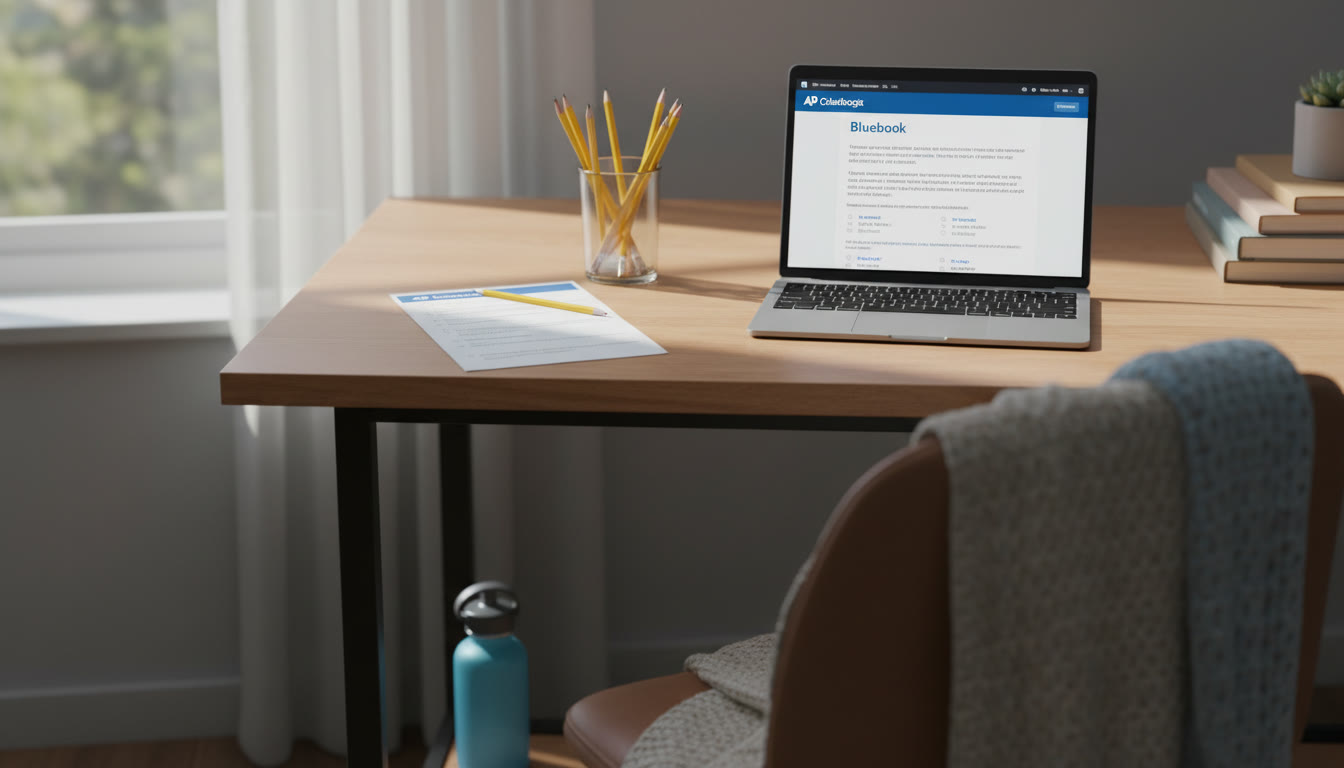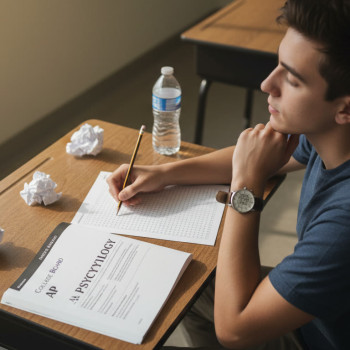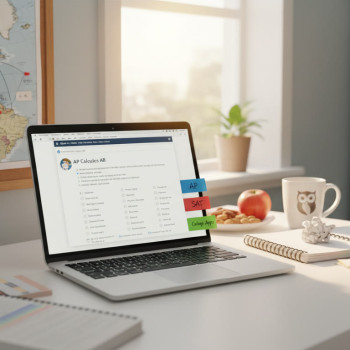Why a Test-Week Checklist Can Change Everything
There’s a special kind of calm that comes from preparation. A single printed checklist in your backpack can dissolve the fog of “Did I forget something?” and let you show up to AP exam day with confidence instead of chaos. Test week isn’t about last-minute miracles — it’s about small, repeatable routines that protect sleep, sharpen focus, and give your brain the space to perform. That’s what this guide is for: clean, printable checklists and practical habits you can actually use.

The simple psychology behind checklists
Checklists work because they shift mental energy from remembering to executing. Instead of juggling dozens of tiny worries (Do I have my ID? Did I charge my device? Did I study that formula?), a checklist externalizes them. That frees up working memory for the task that actually matters: solving the problem in front of you on exam day.
How to use this post: printable PDFs and templates
This article gives you a ready-to-print toolkit for test week. Each section below contains a short checklist you can paste into a one-page PDF or print directly. If you like digital tools, convert the checklist into a note or lock screen image so the items are visible all week. If you prefer paper, print multiple copies: one for your backpack, one at home, and one on your desk.
Files to create (suggested)
- Exam-Day Packing List — 1/2 page
- 24-Hour Before Routine — 1/2 page
- Night-Before Sleep Ritual — 1/4 page
- Pacing Plan (per section) — 1 page
- Post-Exam Reflection — 1/2 page
Core printable: The AP Exam-Day Packing List
Print this as a compact checklist. Tape it inside your backpack flap or fold it into your wallet.
| Item | Why It Matters | Check |
|---|---|---|
| Valid photo ID (if required) | Some sites require ID if you’re testing off campus | □ |
| Printed/phone copy of test schedule & room | Avoids last-minute scrambling | □ |
| Charged testing device with Bluebook (if digital) | Digital exams require Bluebook sign-in | □ |
| Charger and power bank | Some schools allow inspected power banks on desk | □ |
| Approved calculator(s) (if allowed) | Bring backup batteries if needed | □ |
| Two No. 2 pencils and pens (black or dark blue) | For paper parts or free-response booklets | □ |
| Watch (non-smart) | Time management without distractions | □ |
| SSD eligibility letter (if applicable) | Proof of accommodations | □ |
| Light snack and water (in bag for break) | Energy for the break — consumed outside the room | □ |
| Face mask or PPE (if your school requires) | Follow local health/school policies | □ |
Tip: Put all items in a small pouch the night before and leave it by the door. If you’re taking a fully digital or hybrid digital exam, double-check Bluebook login details and save them somewhere secure — but don’t rely on an auto-saved password on the device.
72–24 Hours Before: The Practical Prep Checklist
Three days out is the perfect time to move from studying to stabilizing. That means shifting energy from learning new material to consolidating, practicing pacing, and taking care of logistics.
72 hours checklist
- Finalize travel plans and test location. Confirm room and time with your AP coordinator.
- Print or save your exam ticket and test schedule.
- Run a full timed practice section under test conditions (no phone, timed, at desk).
- Check device updates and download Bluebook; test the app and log in once.
- List any quick facts or formulas you want to glance at during morning review (keep it short).
24 hours checklist
- Pack your exam pouch and lay out clothes (comfortable, neutral, no subject-related slogans).
- Charge your device + power bank, and place chargers in your pouch.
- Get a full night of sleep — aim for consistent time to bed and wake.
- Light review: one short practice set or 20–30 minutes of targeted flashcards.
- Set multiple alarms and program travel time with buffer (aim to arrive 30 minutes early).
The Night-Before Sleep Ritual
Sleep is an evidence-backed performance tool. The brain consolidates memory during sleep — so pulling an all-nighter rarely helps and almost always hurts. Your checklist here is about calming the nervous system, not cramming.
Night-before checklist
- Eat a balanced dinner (protein + complex carbs) and hydrate earlier in the evening.
- Turn off screens at least 60 minutes before bed. Use that time to read lightly or meditate.
- Prepare your exam pouch: pencils, pens, ID, charger, calculator.
- Lay out comfortable clothing the night before.
- Do a 5–10 minute breathing exercise or short walk to reduce adrenaline.
Exam-Morning Routine: Small Acts, Big Payoff
The morning of the exam should be ritualized. Rituals reduce anxiety and create a sense of control.
Morning checklist
- Wake up with time to spare — no rushing.
- Eat a light, familiar breakfast: banana or toast with peanut butter + protein.
- Do a 5-minute warmup: stretch, breathe, visualize doing one practice problem calmly.
- Review the 3–5 key facts you prepared — keep it short and specific.
- Head out early to allow 15–30 minutes buffer for travel and check-in.
Pacing Plans: Turn Time Into Strategy
One of the biggest mistakes students make is mismanaging time during multi-section exams. A printable pacing plan tailored to each AP subject can be a game-changer. Below is a template you can adapt to any AP format.
| Section | Minutes | Strategy |
|---|---|---|
| Multiple Choice (MC) | Variable — allocate 60–75% of MC time | Answer easy first, mark and skip hardest; flag tough ones for a quick review if time remains. |
| Short Answer / Free Response | Break time per question (e.g., 10–15 min each) | Outline first, write concisely, show steps for partial credit. |
| Essay / Long Free Response | 20–40 minutes depending on exam | Spend 5–10 minutes planning, leave 3–5 minutes to proofread. |
Example: For a two-hour test with a 60-minute MC portion, aim to spend no more than 60 seconds per multiple-choice question, then use the remaining time to review flagged items. For paper-based free-response, always plan then write.
Quick Subject-Specific Tips (Printable Snippets)
Each AP subject has its own rhythms. Use these one-liners as printable sticky notes for last-minute confidence boosts.
- AP Calculus: write derivatives of common functions and integral shortcuts on a 3×5 sticky — memorize approaches, not every formula.
- AP Biology: key processes (cellular respiration, photosynthesis) as flow steps; diagrams are friends.
- AP US History: 3-theme thesis template and two evidence anchors per paragraph.
- AP Lang: rhetorical devices checklist — identify device, explain effect, link to author’s purpose.
- AP Chemistry: dimensional analysis first; double-check units at the end of each problem.
What to Do If You’re Taking a Digital Exam
Digital AP exams use a testing app and sometimes require different logistics. Make sure your device is compatible, Bluebook (or the testing app) is installed and up-to-date, and that you know how to use on-screen tools such as the built-in calculator or graphing features.
Digital checklist
- Confirm Bluebook or testing app is installed and you can log in. Practice with a test preview if available.
- Bring charger and approved external keyboard if you’re using a tablet.
- Practice typing or entering answers in the app to avoid surprises with formatting.
Accessibility and Accommodations — Don’t Wait
If you have documented needs, start the accommodation process early. Bring your SSD eligibility letter to every exam that requires it and coordinate with your AP coordinator for any device or testing-room specifics.
Printable PDF Templates — Layout Tips
Design your checklists for quick scanning: use bold headers, small icons, and checkboxes. A 1-column half-page format fits in a wallet or phone case; 1 full page makes a good handout or poster for your study space.
What to include on each printable
- Title and date of the exam
- Top three morning reminders (sleep, breakfast, pouch)
- Two pacing numbers (e.g., MC time per question, minutes per FRQ)
- One short calming cue (e.g., 4-4-4 breathing or a 30-second grounding prompt)
Using Checklists with a Tutor: Personalization Tips
Checklists become exponentially more useful when they’re personalized. If you’re working with a tutor or coach—say, Sparkl’s personalized tutoring—ask them to help you craft a pacing plan that reflects your actual performance on timed practice sections. A tutor can turn a generic checklist into a bespoke sequence of cues and timing adjustments that match how you think and test under pressure.
How a tutor can enhance your checklist
- Identify your typical time-sinks and make targeted pacing items for them.
- Create a prioritized content list: which topics to glance at 24 hours before the exam.
- Provide accountability and quick mock-exam scoring to refine the checklist’s timings.
Sample One-Page Printable (Text You Can Paste)
Below is a compact one-page printable you can paste into a document and export as a PDF.
- Top: Exam Name — Date — Room
- Morning: Wake 2.5 hours early, light breakfast, 5-min warmup
- Pack: ID, 2 pencils, pens, watch, charger, Bluebook device, calculator
- Pacing: MC — 60 sec/Q; FRQ — outline then write, leave 3 min to proof
- Calm Cue: 4-4-4 breathing before section start
- Post Exam: Quick reflection — what went well? One fix for next time
What to Do During Breaks and After the Exam
Breaks are precious. Use them for quick restoration, not for cramming.
Break checklist
- Step outside for a minute of fresh air.
- Move your body: light walk, neck rolls, shrug shoulders.
- Eat a small snack and hydrate (if allowed by your proctor’s rules).
- Do a 30-second breathing reset and a positive cue (“I did the best I could on section one; now I focus on section two”).
Printable Post-Exam Reflection (Short)
Reflection turns effort into learning. After the exam, spend five minutes on this quick form and keep it with your study binder for the next round.
- What surprised me?
- What came easily?
- What will I review differently next time?
- One concrete action I will take this week
Real-World Context: How Students Use Checklists Successfully
Students who adopt a checklist and pacing habit report fewer test-day mistakes and less anxiety. The checklist creates a routine that can be followed even when stress is high. Tutors and teachers often recommend printing a checklist and practicing it in the final two weeks so the routine is as automatic as tying your shoes.
Quick Troubleshooting: Common Exam-Week Problems and Fixes
- Problem: Forgot a charger. Fix: Bring an extra power bank in your car or have a friend carry one.
- Problem: Ran out of time on FRQs. Fix: Practice outlining in the last week and create a 3-minute final-check habit.
- Problem: Device issues with Bluebook. Fix: Test the app 72 hours before and log in once. Have backup sign-in info and contact your AP coordinator immediately if you can’t log in on test day.
Why Small Systems Beat Last-Minute Intensity
Building tiny, repeatable systems — single-page checklists, a 24-hour calm routine, and a pacing plan — gives you leverage. In contrast, last-minute intensity (cramming into the early hours) usually erodes performance. Consider investing time in system design now; it pays off more than extra hours of shallow review.
Closing: Print, Practice, and Protect Your Performance
Download or create the one-page PDFs described above and commit to using them for one week leading up to your AP exam. Treat the checklist like a pre-performance ritual: you don’t negotiate with rituals. They are not a sign you don’t know the content; they’re the glue that lets your knowledge show up on exam day.
And if you’d like tailored support, consider short, focused sessions with a tutor who can turn these checklists into a personalized routine. Sparkl’s personalized tutoring offers 1-on-1 guidance, tailored study plans, expert tutors, and AI-driven insights that can help sharpen pacing, pinpoint time-sinks, and build a checklist that fits how you actually perform under pressure — not just a generic template.

Remember: exam week is temporary; the habits you build will last much longer. A single well-designed checklist doesn’t just help on test day — it trains you to think like a clear, calm problem-solver. Print it, practice it, and go show what you know.
























No Comments
Leave a comment Cancel